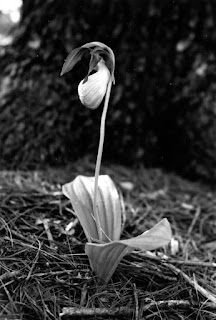When I was a child, I enjoyed playing in the woods in my backyard. My family’s property comprised about three-quarters of an acre – the typical size for a residential area — yet to me, it seemed to extend for miles. Our house and small lawn were bordered on all sides with woods. I was allowed to play anywhere on the property, as long as I didn’t disturb the lone pink ladyslipper flower that grew each spring in the middle of one of the pine groves.
There were many different flowers growing in the yard – crocuses and forsythia in the early spring, red tulips later in the season, and innumerable violets when the weather became warmer. My sister and I would help my mother gather flowers, both wild and cultivated, and arrange them in vases to brighten the house. But the pink ladyslipper was off limits. As beautiful as it appeared, the ladyslipper was not to be picked, my mother explained, because it was a rare flower, best left alone to ensure that it would return, year after year.
If you live on the South Shore and have spent any time at all in the woods in springtime, you have probably come across the pink ladyslipper. For a rare flower, it’s actually quite common. Sometimes hundreds of them grow together in a small area.
Blooming from April to July, the pink ladyslipper, Cypripedium acaule, also known as pink moccasin flower, is generally comprised of two large green leaves at ground level, a 6-12” green stalk, and a distinctive pink, puffy-looking flower, about 2.5 inches in length. The petals resemble a slipper or shoe.
The pink ladyslipper grows in dry forests, especially among pines. It does well both in sandy woods and in rocky mountainous terrain, as long as there is a layer of humus in which it can root. The ladyslipper’s range extends north to Newfoundland and Nova Scotia, west to Saskatchewan and Alberta, and as far south as Alabama and Georgia. There is also a yellow-flower variety, but it is much less common.
Until I began researching this article, I assumed that the ladyslipper was an endangered species. It could be just a child’s poor translation of her mother’s admonitions never to pick the flower – but until recently, I thought that transplanting and/or harvesting a ladyslipper was actually against the law! As yet, I’ve found no evidence to support such an assumption. However I did learn that the ladyslipper’s leaves and stalk are covered with glandular hairs, that when touched, can cause a rash similar to poison ivy. So you really wouldn’t want to pick one…
The pink ladyslipper may not be a rare flower, but it is hardly prolific. Each year the ladyslipper produces a tiny fruit, which contains 10,000 dust-like seeds. When the plant goes dormant in the early summer, the seeds are scattered by the wind. But the ladyslipper – a member of the fickle Orchid family — propagates very poorly – so most of those seeds do not yield any new growth. Occasionally, one of those 10,000 seeds does succeed, and over time, new plants emerge. Twenty years ago, my parents had only one ladyslipper on their property, now there are close to thirty of them!
If you have not yet seen a ladyslipper flower, I suggest you seek one out in the next month or so. Ladyslippers are so odd-looking, it’s well worth taking a few minutes to check one out. You can find them in most of our local wooded conservation areas – like Nelson Memorial Forest in Marshfield, the Norris Reservation in Norwell, and Willow Brook Farm in Pembroke. Remember, it’s okay to look closely – but unless you want an itchy rash, don’t touch!
By Kezia Bacon-Bernstein, Correspondent
May 2004
Kezia Bacon-Bernstein’s articles appear courtesy of the North and South Rivers Watershed Association, a local non-profit organization devoted to the preservation, restoration, maintenance and conservation of the North and South Rivers and their watershed. For membership information and a copy of their latest newsletter, contact NSRWA at (781) 659-8168.

